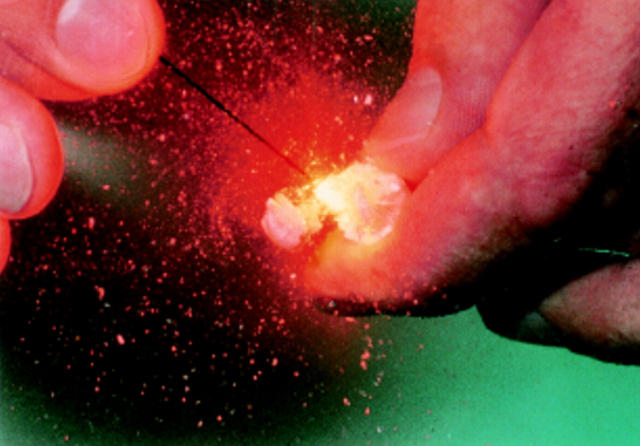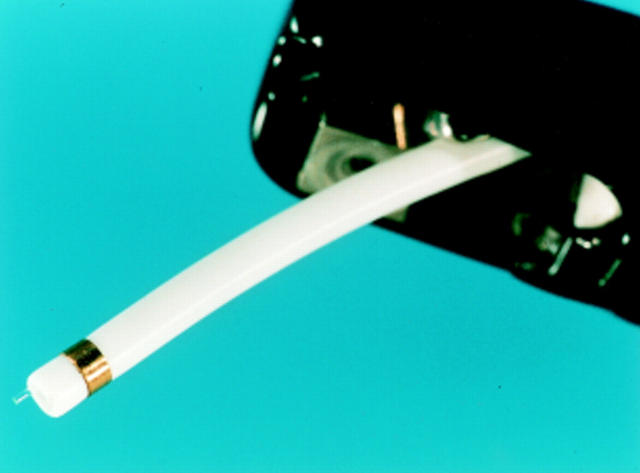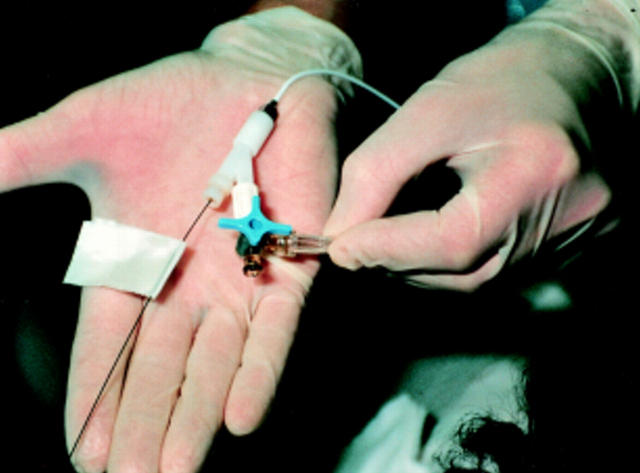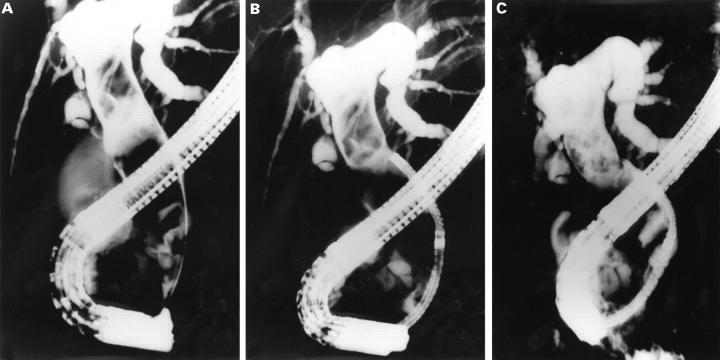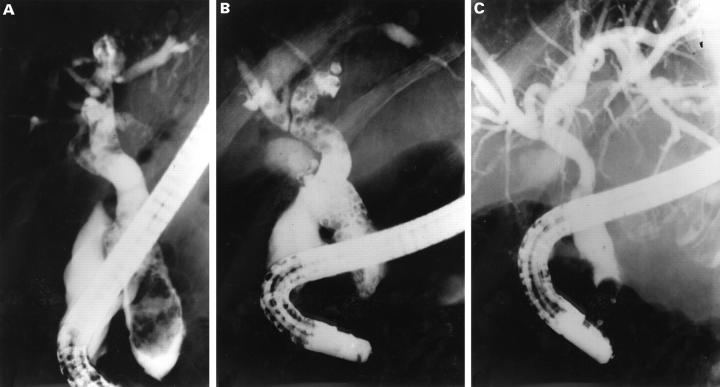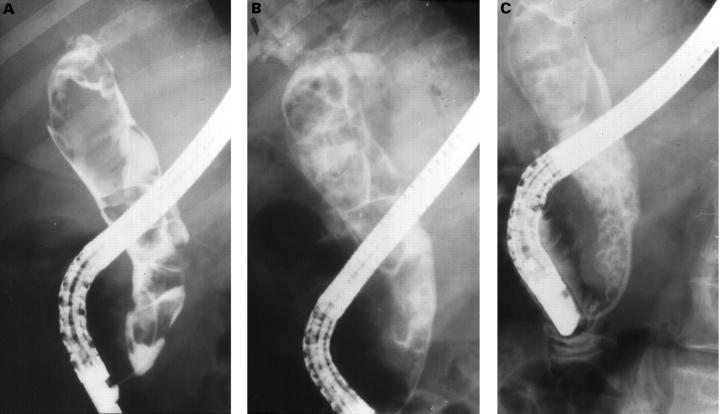Abstract
Introduction—Laser lithotripsy of bile duct stones has become a widely accepted endoscopic treatment modality for giant, impacted, or very hard stones. The procedure is usually carried out under direct endoscopic control in view of the potential risk of bile duct injuries in "blind" laser application. Aims—To investigate the use of a rhodamine 6G laser lithotriptor with an integrated optical stone tissue detection system (oSTDS). Methods—From 1 September 1991 to 7 March 1997, 60 patients with giant or impacted common bile duct stones refractory to endoscopic papillotomy stone extraction, and mechanical lithotripsy were treated via the endoscopic retrograde route using a rhodamine 6G dye laser (595 nm, 2.5 µs, 80-150 mJ pp, Lithognost Telemit/Baasel Corp., Germany) with integrated oSTDS. In case of tissue contact oSTDS cuts off the laser pulse after 190 ns (transmission of 5-8% of the total pulse energy). 47 patients (78.3%) were subjected to x ray targeting (oSTDS) alone, five (8.3%) to choledochoscope targeting alone, and eight (13.3%) to both techniques. Results—At the end of treatment 52 (87%) patients were completely stone-free. The only major complications included transient haemobilia, cholangitis, and pancreatitis in five patients. All five were successfully treated by conservative methods. Conclusions—Laser lithotripsy using the described rhodamine 6G dye laser with oSTDS seems to be safe and effective and allows "blind" fragmentation of difficult common bile duct stones under radiological control only.
Keywords: laser lithotripsy; stone tissue discrimination system; bile duct stones; cholangioscopy; endoscopic therapy; lithotripsy methods
Full Text
The Full Text of this article is available as a PDF (226.2 KB).
Figure 1 .
Laser fragmentation of a biliary concrement using the rhodamine 6G dye laser in vitro.
Figure 2 .
Standard duodenoscope with metal marked 7F plastic catheter, distal metal marking, and central laser fibre.
Figure 3 .
Side flushing system (Tuohy-Borst adapter, William-Cook, Europe) for coaxial irrigation of the laser fibre via a standard 7F ERCP catheter.
Figure 4 .
Laser lithotripsy under direct cholangioscopic vision using a mother and babyscope system before (A), during (B), and after (C) treatment (see Ell et al16; reprinted with permission).
Figure 5 .
Blind laser application of giant common bile duct stones before (A), during (B), and after (C) treatment using the standard ERCP catheter with distal metal marking under control of the oSTDS and intermittent fluoroscopic control.
Figure 6 .
Blind laser application of giant common bile duct stones before (A), during (B), and after (C) treatment using the standard ERCP catheter with distal metal marking under control of the oSTDS and intermittent fluoroscopic control.
Selected References
These references are in PubMed. This may not be the complete list of references from this article.
- Binmoeller K. F., Brückner M., Thonke F., Soehendra N. Treatment of difficult bile duct stones using mechanical, electrohydraulic and extracorporeal shock wave lithotripsy. Endoscopy. 1993 Mar;25(3):201–206. doi: 10.1055/s-2007-1010293. [DOI] [PubMed] [Google Scholar]
- Bonnel D. H., Liguory C. E., Cornud F. E., Lefebvre J. F. Common bile duct and intrahepatic stones: results of transhepatic electrohydraulic lithotripsy in 50 patients. Radiology. 1991 Aug;180(2):345–348. doi: 10.1148/radiology.180.2.2068295. [DOI] [PubMed] [Google Scholar]
- Classen M., Hagenmüller F., Knyrim K., Frimberger E. Giant bile duct stones--non-surgical treatment. Endoscopy. 1988 Jan;20(1):21–26. doi: 10.1055/s-2007-1018119. [DOI] [PubMed] [Google Scholar]
- Classen M., Hagenmüller F. Treatment of stones in the bile duct via duodenoscopy. Endoscopy. 1989 Dec;21 (Suppl 1):375–377. doi: 10.1055/s-2007-1012995. [DOI] [PubMed] [Google Scholar]
- Cotton P. B., Kozarek R. A., Schapiro R. H., Nishioka N. S., Kelsey P. B., Ball T. J., Putnam W. S., Barkun A., Weinerth J. Endoscopic laser lithotripsy of large bile duct stones. Gastroenterology. 1990 Oct;99(4):1128–1133. doi: 10.1016/0016-5085(90)90634-d. [DOI] [PubMed] [Google Scholar]
- Dawson S. L., Mueller P. R., Lee M. J., Saini S., Kelsey P., Nishioka N. S. Treatment of bile duct stones by laser lithotripsy: results in 12 patients. AJR Am J Roentgenol. 1992 May;158(5):1007–1009. doi: 10.2214/ajr.158.5.1348901. [DOI] [PubMed] [Google Scholar]
- Ell C., Hochberger J., May A., Fleig W. E., Bauer R., Mendez L., Hahn E. G. Laser lithotripsy of difficult bile duct stones by means of a rhodamine-6G laser and an integrated automatic stone-tissue detection system. Gastrointest Endosc. 1993 Nov-Dec;39(6):755–762. doi: 10.1016/s0016-5107(93)70259-x. [DOI] [PubMed] [Google Scholar]
- Ell C., Hochberger J., Müller D., Lux G., Demling L. Erste erfolgreiche endoskopisch-retrograde Laserlithotripsie von Gallengangssteinen am Menschen. Dtsch Med Wochenschr. 1986 Aug 1;111(31-32):1217–1217. [PubMed] [Google Scholar]
- Ell C., Hochberger J., Müller D., Lux G., Demling L. Laserlithotripsie von Gallensteinen mittels gepulsten Neodym-YAG-Lasers. Dtsch Med Wochenschr. 1986 Apr 11;111(15):600–601. [PubMed] [Google Scholar]
- Ell C., Lux G., Hochberger J., Müller D., Demling L. Laserlithotripsy of common bile duct stones. Gut. 1988 Jun;29(6):746–751. doi: 10.1136/gut.29.6.746. [DOI] [PMC free article] [PubMed] [Google Scholar]
- Hochberger J., Gruber E., Wirtz P., Dürr U., Kolb A., Zanger U., Hahn E. G., Ell C. Lithotripsy of gallstones by means of a quality-switched giant-pulse neodymium:yttrium-aluminum-garnet laser. Basic in vitro studies using a highly flexible fiber system. Gastroenterology. 1991 Nov;101(5):1391–1398. doi: 10.1016/0016-5085(91)90093-z. [DOI] [PubMed] [Google Scholar]
- Jakobs R., Adamek H. E., Maier M., Krömer M., Benz C., Martin W. R., Riemann J. F. Fluoroscopically guided laser lithotripsy versus extracorporeal shock wave lithotripsy for retained bile duct stones: a prospective randomised study. Gut. 1997 May;40(5):678–682. doi: 10.1136/gut.40.5.678. [DOI] [PMC free article] [PubMed] [Google Scholar]
- Kawabe T., Komatsu Y., Tada M., Toda N., Ohashi M., Shiratori Y., Omata M. Endoscopic papillary balloon dilation in cirrhotic patients: removal of common bile duct stones without sphincterotomy. Endoscopy. 1996 Oct;28(8):694–698. doi: 10.1055/s-2007-1005579. [DOI] [PubMed] [Google Scholar]
- Koch H., Rösch W., Walz V. Endoscopic lithotripsy in the common bile duct. Gastrointest Endosc. 1980 Feb;26(1):16–18. doi: 10.1016/s0016-5107(80)73252-2. [DOI] [PubMed] [Google Scholar]
- Lux G., Ell C., Hochberger J., Müller D., Demling L. The first successful endoscopic retrograde laser lithotripsy of common bile duct stones in man using a pulsed neodymium-YAG laser. Endoscopy. 1986 Jul;18(4):144–145. doi: 10.1055/s-2007-1018356. [DOI] [PubMed] [Google Scholar]
- Martin E. C., Laffey K. J., Bixon R. Percutaneous transjejunal approaches to the biliary system. Radiology. 1989 Sep;172(3 Pt 2):1031–1034. doi: 10.1148/172.3.1031. [DOI] [PubMed] [Google Scholar]
- Mathuna P. M., White P., Clarke E., Merriman R., Lennon J. R., Crowe J. Endoscopic balloon sphincteroplasty (papillary dilation) for bile duct stones: efficacy, safety, and follow-up in 100 patients. Gastrointest Endosc. 1995 Nov;42(5):468–474. doi: 10.1016/s0016-5107(95)70052-8. [DOI] [PubMed] [Google Scholar]
- Neuhaus H., Hoffmann W., Gottlieb K., Classen M. Endoscopic lithotripsy of bile duct stones using a new laser with automatic stone recognition. Gastrointest Endosc. 1994 Nov-Dec;40(6):708–715. [PubMed] [Google Scholar]
- Neuhaus H., Hoffmann W., Zillinger C., Classen M. Laser lithotripsy of difficult bile duct stones under direct visual control. Gut. 1993 Mar;34(3):415–421. doi: 10.1136/gut.34.3.415. [DOI] [PMC free article] [PubMed] [Google Scholar]
- Neuhaus H., Zillinger C., Born P., Ott R., Allescher H., Rösch T., Classen M. Randomized study of intracorporeal laser lithotripsy versus extracorporeal shock-wave lithotripsy for difficult bile duct stones. Gastrointest Endosc. 1998 May;47(5):327–334. doi: 10.1016/s0016-5107(98)70214-7. [DOI] [PubMed] [Google Scholar]
- Nishioka N. S., Kelsey P. B., Kibbi A. G., Delmonico F., Parrish J. A., Anderson R. R. Laser lithotripsy: animal studies of safety and efficacy. Lasers Surg Med. 1988;8(4):357–362. doi: 10.1002/lsm.1900080404. [DOI] [PubMed] [Google Scholar]
- Ponchon T., Gagnon P., Valette P. J., Henry L., Chavaillon A., Thieulin F. Pulsed dye laser lithotripsy of bile duct stones. Gastroenterology. 1991 Jun;100(6):1730–1736. doi: 10.1016/0016-5085(91)90676-c. [DOI] [PubMed] [Google Scholar]
- Prat F., Fritsch J., Choury A. D., Frouge C., Marteau V., Etienne J. P. Laser lithotripsy of difficult biliary stones. Gastrointest Endosc. 1994 May-Jun;40(3):290–295. doi: 10.1016/s0016-5107(94)70058-3. [DOI] [PubMed] [Google Scholar]
- Riemann J. F., Kohler B., Weber J., Schlauch D. Intraductal shock-wave lithotripsy in complicated common bile duct stones. Clin Investig. 1992 Feb;70(2):148–151. doi: 10.1007/BF00227357. [DOI] [PubMed] [Google Scholar]
- Sauerbruch T., Feussner H., Frimberger E., Hasegawa H., Ihse I., Riemann J. F., Yasuda H. Treatment of common bile duct stones. A consensus report. Hepatogastroenterology. 1994 Dec;41(6):513–515. [PubMed] [Google Scholar]
- Sauerbruch T., Holl J., Sackmann M., Paumgartner G. Fragmentation of bile duct stones by extracorporeal shock-wave lithotripsy: a five-year experience. Hepatology. 1992 Feb;15(2):208–214. doi: 10.1002/hep.1840150207. [DOI] [PubMed] [Google Scholar]
- Schneider M. U., Matek W., Bauer R., Domschke W. Mechanical lithotripsy of bile duct stones in 209 patients--effect of technical advances. Endoscopy. 1988 Sep;20(5):248–253. doi: 10.1055/s-2007-1018186. [DOI] [PubMed] [Google Scholar]
- Schreiber F., Gurakuqi G. C., Trauner M. Endoscopic intracorporeal laser lithotripsy of difficult common bile duct stones with a stone-recognition pulsed dye laser system. Gastrointest Endosc. 1995 Nov;42(5):416–419. doi: 10.1016/s0016-5107(95)70042-0. [DOI] [PubMed] [Google Scholar]
- Sherman S., Hawes R. H., Lehman G. A. Management of bile duct stones. Semin Liver Dis. 1990 Aug;10(3):205–221. doi: 10.1055/s-2008-1040476. [DOI] [PubMed] [Google Scholar]
- Tytgat G. N., Meenan J. K., Rauws E. A., Huibregtse K. Endoscopic biliopancreatic balloon dilation. Endoscopy. 1996 May;28(4):367–371. doi: 10.1055/s-2007-1005483. [DOI] [PubMed] [Google Scholar]



